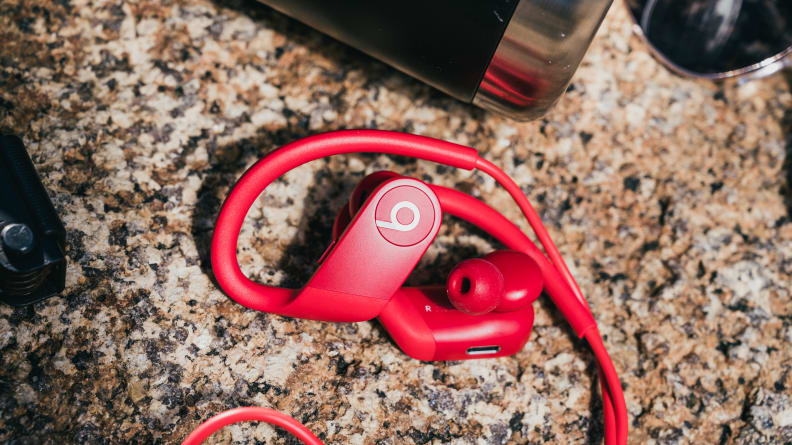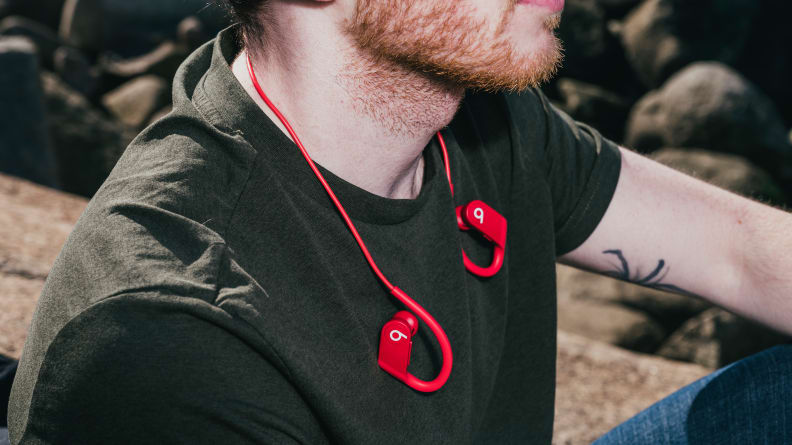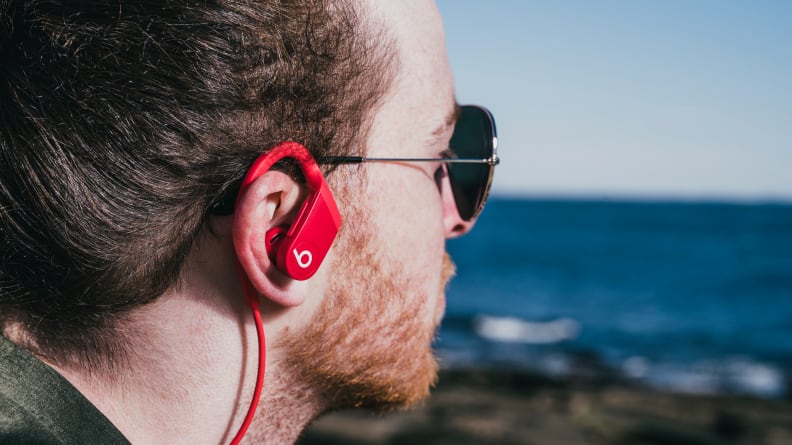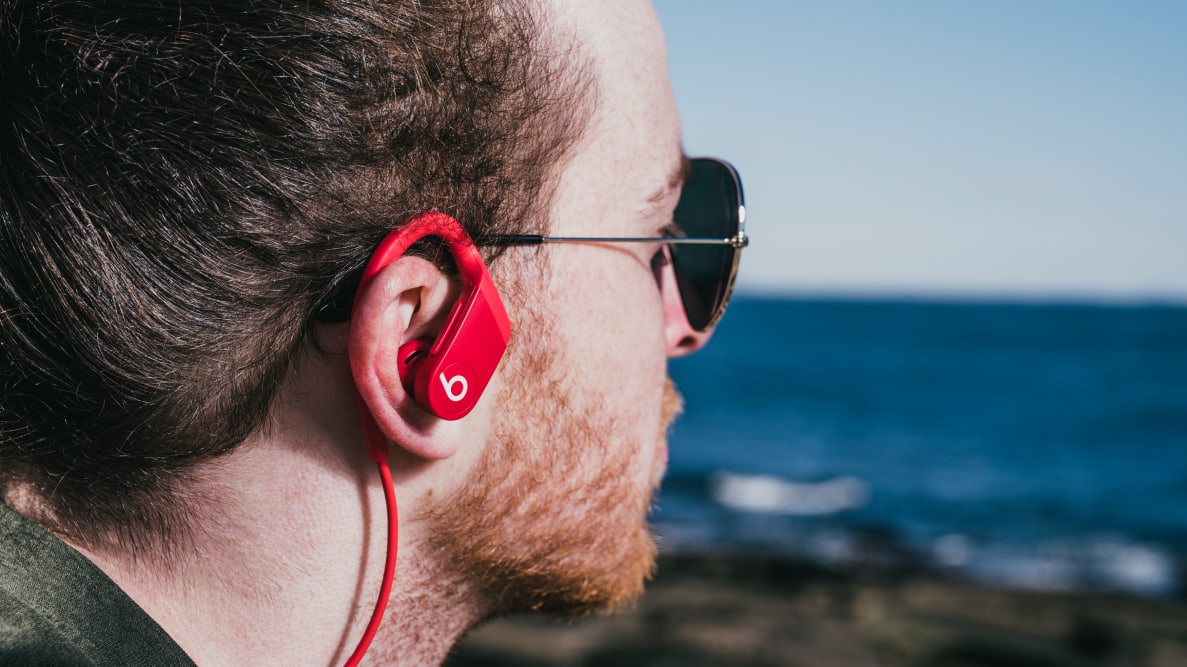Pros
-
Incredible wireless range
-
Clear, powerful sound
-
Workout ready
Cons
-
No transparency mode
-
Ear hooks can get uncomfortable
The idea of wiring the Powerbeats Pro together seems like an odd move at first. The vast majority of new wireless earbuds are of the totally (or “true”) wireless variety, and chaining together a pair designed specifically to be free of such constraints feels counterintuitive. Then again, if you’re going to make a more affordable pair of neckband 'buds anyway, why reinvent the wheel when you can just reconnect it?
After all, the Powerbeats Pro sound much better than 2016’s Powerbeats3, and other Powerbeats models before them. They’ve got plenty of other advantages, too, from intuitive built-in controls to Apple’s prized H1 chip, designed for easy pairing and strong wireless connection. The new Powerbeats promise all that and more for up to $100 less. The tradeoff? One little wire.
About the Beats by Dre Powerbeats

The Powerbeats are nearly exactly like the Powerbeats Pro, but with a wire connecting them.
The Powerbeats made their official debut March 18, 2020. Apart from the wire that binds the 'buds together, their features line up almost precisely with the Powerbeats Pro, with a few exceptions.
Accessories include four pairs of eartips, the smallest Lightning cable in the galaxy, and a travel pouch in lieu of the portable charging case that comes with the Pro. As an Apple product (Apple acquired Beats in 2014), the Powerbeats are naturally pricier than many competitors, but they do appear resilient and well built.
Here are the basic specs:
-
Price: $149
-
Battery life: 15 hours
-
Quick charge: 1 hour of playtime in 5 minutes
-
Driver size: 12mm
-
Water resistance: IPX4 rated
-
Available colors: Black, Red, and White
-
Calling: Dual beamforming mics, speech detecting accelerometer
- Fit: small, medium, large, and double flange ear tips
- Weight: 26.3 grams
What we like
Easy pairing, smooth controls
Banded wireless earbuds are inherently easier to pair than most true wireless earbuds not made by Apple–pairing one device to your phone is usually simpler than two. Still, the Powerbeats are easier than most, especially for iPhone users. Simply power them on and, as long as your phone has the latest iOS update, they’ll appear automatically on your screen just like the AirPods and Powerbeats Pro before them.
As with those other Apple ‘buds, pairing the Powerbeats to an Android device is trickier, requiring you either select them from your Bluetooth settings or, in this case, download the Beats app which allows for perimeter pairing.
The controls are equally simple and (in our opinion) far superior to a dangling three-button mic piece. Unlike the Powerbeats Pro–which mirror the controls on both ‘buds so you can use one at a time–the Powerbeats' right bud houses the main controls, including a volume rocker and a multi-function key on the circular Beats logo for song skip, play/pause, and calling. The left earbud houses a single power/pairing key. Easy breezy.
We will utter one small complaint: pressing the multi-key tends to force the right ‘bud into your ear, a relatively common annoyance for such onboard controls.
Ridiculous wireless range
In 7 years of earbuds testing, I’ve never had a pair with a wireless connection as broad or as binding as the Powerbeats. With my phone on the counter, I rambled all over my house, including my backyard and patio, never experiencing even a blip of connection drop. A colleague had a similar experience trudging through hallways, stairwells, and behind brick walls in our Cambridge, MA, office.

Neckband earbuds have their disadvantages, but wireless range is not one of them.
While Apple’s AirPods generally rank among the best in their genre for connection, no true wireless earbuds were as solid in our testing as the Powerbeats—and the majority fare much worse. This is likely due in part to the fact that the Powerbeats boast Class 1 Bluetooth, which offers 100 meters of range, rather than the common 10 meters for Class 2 devices. Bluetooth always defaults to the lowest class, so range may vary depending on your phone, but color us impressed nonetheless.
Tied for the best sounding Beats 'buds you can buy
As expected, the Powerbeats sound just like the Powerbeats Pro, and in this case that’s a good thing. Apple went back to the drawing board for the Pro, seeming to focus on two major pain points of previous models: Bass that was ill-defined and intrusive, and a lack of presence or definition in the midrange.
The resulting sound signature for the new Powerbeats models is far and away the best we’ve heard from Beats earbuds. While they keep the bass-forward sound that put Beats on the map, they add a steady hand of restraint to let the other frequencies flourish. Not only that, but the bass itself sounds much better than other Beats ‘buds, presenting a rich, chocolatey flavor that is joyfully musical and accurate.
That’s not to say bass doesn’t sometimes get too aggressive—especially for those who prefer a more balanced sound signature, like yours truly. It rarely becomes overpowering to the point of unpleasantness, though, allowing the crisp clarity in the midrange and treble detail like the slapback echo on vocals or the soft brushwork atop a snare to shine through. The result is a sound that should satisfy bass-heads and regular listeners alike.
Solid build quality
This is a tough one to judge in a week or two, but based on Apple’s track record and the design of the Powerbeats, we’re confident in saying they rank highly in build quality when compared with competitors. Even at their $250 MSRP, I was impressed with the heavy plastic and rubberized materials of the Powerbeats Pro, and it appears little if anything has changed there. The Powerbeats feel solid in your hands and their rigid plastic should hold up against bumps and bruises.
Ready for any workout you can throw at them

The Powerbeats are designed to go anywhere you do.
The Powerbeats’ IPX4 rating means they’ve been tested to withstand sweat, splashes, and inclement weather. They’re not fully waterproof (you can’t dunk them) and there are plenty of other earbuds, including the aforementioned Jabra Elite Active line (65t and 75t) that offer more protection, but you should be fine for everything from a 5K to a marathon regardless of mother nature’s plans.
The famous Beats ear hooks offer another level of stability, assuring the Powerbeats stay in place in virtually any scenario. They’re not the easiest to clip on, and comfort over the long term is also something to consider if you’re buying these earbuds for everyday use (more on that below), but worries about earbuds popping out can be put to rest.
Class-leading battery life ... sort of
This one is a little tricky. On the surface, the Powerbeats’ 15 hours of playback time is among the best on the market for wireless earbuds regardless of price, edging out the Powerbeats Pro and most other neckband buds we've experienced. For that, we’ll give them a nod, but there's more to the story.
The Powerbeats Pro (and virtually every other pair of true wireless earbuds) come with a portable charging case with multiple recharges for powering up on the go. In the case of the Pro, that equates to a total off-the-grid battery life of around 24 hours, while others push that number to as much as 40 hours or more. That leads us to our first knock.
What we don’t like
No charging case means more time on the shelf

Neckband earbuds don’t normally come with a charging case so it may seem unfair to call out the Powerbeats here. When looking at the overall market value, though, it’s worth noting. For the Powerbeats' $149 launch price you can get any number of true wireless earbuds, from value picks like 1More’s highly affordable Stylish to models with active noise attenuation like Amazon’s Echo Buds, each with its own charging case.
To make matters worse, the Powerbeats lack an auto-power down feature, so it’s easy to leave them on. On the bright side, quick charging gives you an hour of playback in just 5 minutes.
The app and workout features are lacking for 2020

The Powerbeats are ready to go wherever you do.
There are other concessions you’ll make in buying the Powerbeats, too. A big one is transparency (aka "hearthrough" or "ambient") mode, which filters in audio from the world around you to keep you safe outdoors. It may seem like a luxury, but in today’s earbuds market, $150 will net you this handy feature more often than not.
The app is also lackluster, offering no EQ settings, fitness tracking, or other useful features you’ll see in options from Sony, Jabra, and others.
iOS first, Android second
While the Powerbeats aren’t the worst offenders in Apple’s camp, Android users may feel a little like second-class citizens. Whether it’s the simpler wireless pairing, hands-free Siri access, or the laughably small Lightning cable (which seems to assume you’ve got regular-sized versions lying around), Apple users get a more premium experience.
In fact, the Powerbeats won’t even show a battery gauge on Android phones outside the app, which is basically the only reason to use it. That makes checking status less convenient, exasperated by the lack of a charging case.
It’s not that Android users can’t enjoy the Powerbeats (we did) but it’s something to be aware of.
Not the comfiest ride in town

While the ear hook design is great for workouts, they're not as comfortable with glasses.
Finally, we have to call out once again that, while the ear hooks may be excellent for keeping these ‘buds in place, they’re not great for longterm comfort. They’re difficult to put on, awkward over glasses (especially sunglasses), and they wore a bit on our ears over time.
The rigid Powerbeats housings add to the issue, making them uncomfortable for listening sessions of a couple of hours or more. That’s fine if you only use these ‘buds to get a sweat, but if you need something for commuting or working (at home or the office), it could be an issue.
Should you buy them?
Maybe—If you’re a Beats lover and wait for the price to drop.
Whether it’s the improved sound, the long battery life, or the incredible wireless range, those looking for that Beats logo on your next earbuds have some good reasons to say yes to the Powerbeats—as long as you don’t mind a pair of neckband buds. For iPhone/Mac users, hands-free Siri, ultra-simple pairing, and quick device switching also sweeten the deal. At $150, they're pricey, but we also expect that price to drop with time as low as $100, which will make these an even better value.
There’s also reason to push pause for now, though. While built for workouts, the Powerbeats lack the transparency mode and fitness tracking that many new workout buds at their price include. Conversely, their ear-hook, workout-first form factor makes them something of a one-trick pony.
Then there’s the flood of true wireless earbuds at or near the Powerbeats’ price point, from Jabra’s value-packed Elite and Elite Active lines to the aforementioned Echo Buds and 1More Stylish. The convenience of totally wireless freedom can’t be overestimated, especially for working out, and those examples barely scratch the surface.
All that aside, as Beats was no doubt counting on, if you’ve been drooling over the Powerbeats Pro but can't stomach the price, the Powerbeats could be a great compromise.
Meet the tester
Hailing originally from Montana, Ryan parlayed his time working as a musician and audio engineer into a career in digital media in 2012. Since then he's had extensive experience as a writer and editor, including everything from op-eds and features to reviews on TVs, audio gear, smart home devices, and more.
Checking our work.
Our team is here to help you buy the best stuff and love what you own. Our writers, editors, and experts obsess over the products we cover to make sure you're confident and satisfied. Have a different opinion about something we recommend? Email us and we'll compare notes.
Shoot us an email

